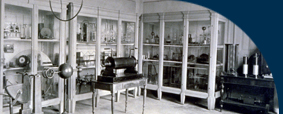| Boxwood, bone, iron, paint with sealing-wax |
Materiali utilizzati: Bosso, osso, ferro, ceralacca |
Nobili describes the item as follows: «It consists of three main parts: the first is a box-wood base, the upper part crafted in the shape of a container, and which has a perforation in the centre towards the bottom. There is also a lateral perforation that communicates with the other. The second part is a magnetized cylinder, which is half-covered by the base and which has a small cup on its top. The third part consists of a mobile conductor xx [now lacking]. (The mobile conductors are joined to the lid of the box). In order to activate the device, the lateral hole of the base is first filled with mercury. Second, the point of the mobile conductor is placed on the top of the magnetized cylinder. (The top is covered by a concave piece of glass to reduce the friction). Third, some mercury is poured into the cup of the magnet and into the container of the base. Here the mercury must barely reach the lower point of the mobile conductor. In the fourth and last stage, the two connecting wires of an electromotor are taken in one's hands and are placed so that one reaches the mercury in the lateral hole of the base, and the other one reaches the mercury in the container (in this way of communication current flows through the magnet). When this action is carried out, the mobile conductor starts turning around the magnet. By inverting the position of the two connecting wires, the circuit itself is inverted, and therefore even the rotation in the mobile conductor changes direction (Faraday)» [Nobili 1834]. |
Nobili così descrive il pezzo: «E' composto di tre parti principali. La prima è uno zoccolo di busso [sic] incavato al di sopra in forma di vaschetta, e bucato nel mezzo sin verso il fondo: oltre a questo buco centrale ve ne ha un altro laterale che comunica col primo. La seconda parte è un cilindro calamitato sepolto per metà dentro il zoccolo, e guernito alla sua sommità d'una piccola coppa. La terza parte consiste nel conduttor mobile xx [mancante]. (I conduttori mobili sono applicati al coperchio dell'astuccio). Per mettere in azione quest'apparecchio si comincia dal riempire di mercurio il buco laterale del zoccolo. In secondo luogo si pone la punta del conduttor mobile sulla cima del cilindro calamitato. (Questa sommità è coperta d'un pezzettino concavo di vetro per diminuire gli attriti). Si versa in terzo luogo un pò di mercurio nella coppa della calamita e nella vaschetta del zoccolo. In quest'ultima il mercurio debbe arrivare appena alla punta inferiore del conduttor mobile. In quarto ed ultimo luogo si prendono in mano i due fili congiuntivi d'un elettromotore, e si fanno pescare l'uno nel mercurio del buco laterale del zoccolo, e l'altro in quello della vaschetta. (in questo modo di comunicazione la corrente passa per la calamita). Al momento in cui si compie l'ultima operazione, il conduttor mobile si mette a girare dintorno alla calamita. Col porre l'uno de' fili congiuntivi al posto dell'altro s'inverte il circuito, e con ciò si rovescia pure la rotazione nel conduttor mobile (Faraday)» [Nobili 1834]. |

